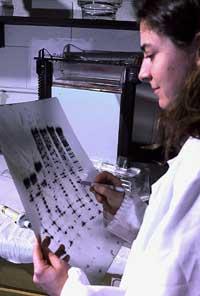New DNA reading dyes

Dye-based DNA reading techniques are used in genome research. Its sequence is broken and treated with specific dyes. Each dye is associated with a single type of base, so for the
base types four fluorescent dyes are used, so that each base (adenine, guanine, cytosine and thymine) is assigned a color. Finally, through the light a fluorescence is produced in the sample and the sequence of colors that can be read is shown. This sequence lets you know the original string.
However, these dyes cause problems. Due
to the rotation and vibration movement of the molecules, they emit photons of different wavelengths, that is, of different colors. This can cause color changes and interference. This leads to errors in DNA analysis.
Scientists at Marquette University in the United States prepare dyes that will not lead to these problems. So far two dyes have been made that cannot overlap wavelengths. One of them is excited with two photons to produce fluorescence and the other with a single photon. The latter emits a light of greater wavelength than the former. As there are four types of bases, four dyes are needed and not two. Therefore, scientists will try to prepare four, two of them excited by a single photon and two other photons.
The fluorescence of two photons requires very powerful lasers, but according to experts, new generation lasers will achieve this effect at a lower price than expected. Researchers are becoming as simple as possible to launch a machine that detects two types of fluorescence simultaneously.
Buletina
Bidali zure helbide elektronikoa eta jaso asteroko buletina zure sarrera-ontzian











